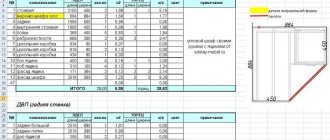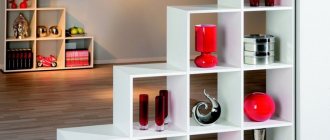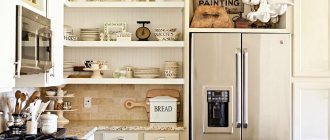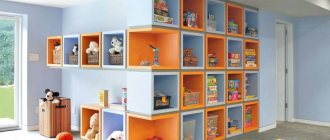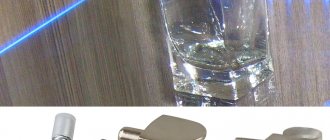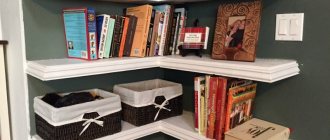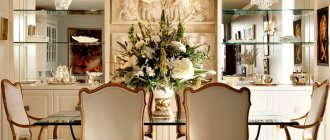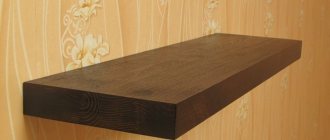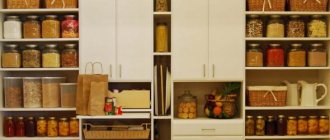Mirrors, shelves, doors, stained glass windows and other glass objects are an integral part of the interior of a residential building. Most often, mirrors are found in the hallway and in the bathroom. And shelves, stained glass windows and doors made of such material are less popular, but are not excluded as decor. Despite their different functionality, all these products are united by increased fragility. Therefore, the standard wall fastening system is not suitable. In this case, it is necessary to use special fasteners for glass.
Types of fittings and fasteners for installing glass products
The choice of fittings for fastening glass and other fragile products is made taking into account the location of the object in space (vertical or horizontal), as well as the level of expected load on it. Based on this, the following types of fastening can be distinguished:
- point;
- clamping;
- on an adhesive basis.
Point fastening is performed by attaching the clamp to the glass sheet through a special hole. This clamp is called a connector. It is made of stainless steel. Its design contains a sealing gasket, which ensures excellent tightness of the connection and protects the glass sheet from damage during operation.
Clamp fastening is performed by fixing the clamp without making a hole in the blade. It can be carried out using point clamps (corners, clips). Sometimes it is attached using a glass profile to a wall or to another object.
Glue-based fastening is rarely performed, as it is considered less reliable. This mount is used to install glass or mirror on the wall. The product can be fixed using double-sided construction tape or a special adhesive composition.
Fastening glass products to the wall is best done using a silicone-based adhesive.
Regardless of the type of fastening, the fittings should be selected taking into account its scope of application:
- fixing glass to glass;
- installation of glass to the wall;
- using glass as part of another structure, for example, when attaching glass doors to furniture.
How to attach glass to a wall: two methods to solve the problem
Shelf holders
There are two so-called. fasteners for glass to the wall, with which you can install glass shelves - these are holders for the latter and a special aluminum profile. Both methods of fastening fulfill their assigned tasks. There is only one difference between them - a different method of installing glass.
In addition, the holders are universal, thanks to them you can attach glass of any thickness to the wall, while an aluminum profile, on the contrary, fits a certain size. However, the latest mount for a glass shelf has one significant advantage - you can insert LEDs into the aluminum profile and illuminate the glass inside. You can read more about this in the article on our website “Illuminated Glass Shelves”.
To understand which aluminum profiles are suitable for attaching glass shelves, the article “Aluminum profile - description of its various types and designs” will help you. Also familiarize yourself with the various types and configuration options of aluminum profiles. The world's leading manufacturer of aluminum profiles, including such specific ones as for mounting glass shelves with suspension - the Scandinavian company Sapa Building System. Read more about it here: https://oknanagoda.com/steklo/konstrukcii-alyum-profil/sapa-obsv.html
Profile for glass shelf
The fastener for a glass shelf is quite easy to install - it consists of two elements: a base attached to the wall, and an upper decorative support. Separating them is quite simple - the base can be easily pulled out of the upper support.
Then, when the holder is disassembled, use a level to mark the shelf mounting surface on the wall. The base of the shelf holder is marked relative to this surface using dowels, which are included with the mount.
Illuminated glass shelves
Please note that only two holders are needed to attach one glass shelf. They are used to fasten the glass to the wall end-to-end, on both sides of the shelf with a gap of at least 5 cm from the edge. However, depending on the length of the glass shelf and the planned load on it, the number of holders may be greater.
Despite the variety of fastening methods, the main requirement is reliability and perfection.
How to choose glass fittings
When choosing accessories for fastening glass, you should rely on the type of item itself, its location and functionality. If you are selecting a fastening element for installing a mirror or other glass structure in the bathroom, you should give preference to parts made of stainless metal (steel, zinc, brass). It is also worth paying attention to the decorative appearance. This detail must fit neatly into the design of the product. Fasteners on glass must have a protective gasket so that during contact with the canvas it does not deform.
Features of choice
The holder for glass shelves should be different:
- safety margin, since glass is a fragile material;
- reliability of fixation. As a rule, shelf holders are equipped with special clamps that secure the shelf in the fittings;
- safety of use. The fastening should not have sharp corners, roughness or other defects that could lead to damage to the surface.
When choosing, you need to consider:
- type of fittings;
- material of manufacture;
- technical specifications.
Types of shelf holders for glass
To attach glass shelves to a wall or in a cabinet, only external holders are used, since it is impossible to install hidden fittings in the glass. Among the external elements the following stand out:
- overhead shelf holders. The simplest and most inexpensive type of furniture fittings for shelves, characterized by easy installation. To protect the surface of the shelf, a rubber or plastic pad is installed. Among the disadvantages are the low level of strength, since the glass shelf is simply placed on the holder and is not fixed in it, and the need for a clear location of fasteners around the perimeter of the shelf, since even a slight misalignment under load can lead to cracking of the surface;
Overlay shelf holders for glass
Spruce for overhead shelves is mainly used when installing a shelf in a closet or in any other piece of furniture.
- shelf holders with suction cup. Fittings are a type of overhead. To achieve greater strength of the shelf, a special suction cup is installed on the surface of the holder, which allows you to fix the glass surface. Shelf holders with suction cups can be used both for mounting a shelf inside a cabinet and for attaching furniture to a wall;
Fastening element with glass fixation using a suction cup
- shelf holders with clamp. The most popular types of fittings for glass shelves, allowing you to securely fix the device both on the wall and in the closet. The most popular shelf holders with clips are called pelicans. Pelican or toucan is a streamlined fitting consisting of three main elements: an upper part, a “beak” that holds the glass in a given position, and elastic gaskets that prevent damage to the surface inside the beak.
Glass holder with clamp
Fasteners with the ability to clamp glass can be produced in a different form, for example, in the form of brackets of different lengths, which allows you to give the shelf additional uniqueness.
Shelf holder in the form of a bracket with a locking function
Selection of material for making accessories
Holders for glass shelves can be made:
- made of plastic. Such fittings are characterized by minimal strength and cannot withstand a load of more than 5 - 7 kg. However, the low cost and the presence of a smooth surface without nicks or roughness, which eliminates the possibility of damage to the glass surface, attract a large number of users;
Plastic shelf holders for glass shelves
- made of metal. For production, steel with additional coating is used to protect the material from corrosion, chrome and bronze, which are characterized by high strength and high cost, brass, nickel and other alloys. Metal holders are designed for shelves with higher loads. To protect the glass surface, special gaskets made of rubber, plastic or other similar materials are used.
Determination of technical parameters
The final stage of selection is the determination of the technical parameters of furniture fittings. Important things to consider:
- thickness of the glass shelf. This parameter is important when choosing fittings with the ability to clamp glass, since the “beak” of a Toucan shelf holder or any other type is intended exclusively for certain parameters;
- shelf weight and maximum load. All types of fasteners are designed only for a certain weight. The parameter is indicated in the accessories passport;
- shelf width. This indicator is determined when choosing a bracket, since for strong fixation it is necessary that the length of the holder be at least 30% of the width of the shelf.
Installation of glass fittings
There are two ways to install fittings to glass:
- by gluing;
- using a drill.
Installation of fittings with glue
The easiest way to fix a part that is glued with glue. The process of its installation is carried out by applying an adhesive composition to that part of the fittings that will be adjacent to the glass. Next, fixation is carried out using a screw clamp. You can install such fittings yourself, and the chance of damaging the fabric is minimal.
The use of adhesive fittings is permissible only if the weight of the items does not exceed 20 kg.
Installation of fittings with drilling
To install and fasten glass using drilling, use accessories for which you need to prepare a hole in the panel. Such fasteners allow the installation of heavier elements or products designed for greater loads. In this case, it is also necessary to make a recessed hole in the wall for reliable fixation.
The fastening part that requires a hole is made of metal. But to avoid direct contact with the glass sheet, the contact point is protected with a rubber or silicone gasket.
Features of self-installation of glass products
When installing glass structures yourself, you must follow a number of rules to ensure that the product is functional and lasts a long time.
- They determine the location of the glass structure or object, where it will be located - in the bathroom or in the hallway.
- Choose a suitable fastening method (adhesive mounting or installation of special fittings).
- Having chosen the fastening method using fittings, select the appropriate fasteners.
- Depending on the fasteners, they are installed in the correct order.
- Check the reliability of the work performed.
Tips for installing mirrors yourself
When installing a mirror yourself, you should consider many factors. Each material requires a certain type of fastener.
The mirror is fixed to the concrete wall using glue. It is worth considering that glue is not always able to withstand a massive product, so you can use a combination of glue with double-sided tape.
The mirror sheet is fixed to the plasterboard wall using holders. It must be remembered that drywall can be deformed if there is a strong impact on it, so the weight of the mirror sheet should be taken into account.
Rules for installing glass shelves yourself
Attaching a glass shelf yourself is not difficult, if you consider the following:
- To secure a shelf no more than 50 cm long and 20-25 cm wide, only two holders are required, but if you intend to install a longer shelf, the number of holders increases.
- Before installing fittings for a glass shelf, you should mark its location (the holders must be attached so that the shelf is horizontal and level without distortion).
- When installing several shelves, it is better to start installation from the top row.
By following these tips, you can independently carry out a number of activities to install any glass element and structure.
Did you manage to solve your problem using the recommendations from the article?
Yes!
51.52%
No. More answers required. I'll ask in the comments now.
27.27%
Partially. There are still questions. I'll write in the comments now.
21.21%
Voted: 33
Furniture and interior items
64 votes
+
Vote for!
—
Vote against!
Glass shelves will never go out of style, especially in apartments with a modern style. This is one of the simplest and most multifunctional decorative elements. However, it is often the proper fastening of glass shelves to the wall that causes some difficulties, without which they will not become an effective and safe addition to the interior. The fewer fittings and fasteners, the lighter the transparent structure made of glass elements looks, on which anything can be placed in any room.
Table of contents:
- Glass shelves in the interior
- Advantages of glass as a material for making shelves
- Types of transparent shelves
- Methods for attaching holders for glass shelves
Glass shelves in the interior
A collection of rare items, a shelf for books or CDs, a stand for hanging indoor plants - you never know what corner glass shelves on the wall can be useful for. Their uniqueness is that even if you make a whole rack for shelves or a niche in the wall, it will not look bulky. Many shelves on brackets or special holders can easily replace wooden cabinets for equipment in the living room or other cabinet furniture in any room. They are appropriate in the bedroom and bathroom, in the kitchen and in the office, for example, glass shelves on the wall, photo:
The multi-seat and multi-level glass structure looks elegant and light. It seems that not only light, but also air penetrates through the transparent stands. Made from durable and thick glass, glass wall shelves have a decent weight but look almost weightless. They are practically invisible, so they do not clutter up the space, and this is an indispensable property for decorating small rooms where there is not enough space for full-fledged furniture.
But at the same time, the effect of empty space is successfully used by designers for other purposes:
- for zoning large rooms;
- for decorating a minimalist interior;
- to replace bulky hanging shelves made of wood, etc.
The interior of any room with “invisible” shelves will be transformed, it will become more refined, sophisticated and modern. The fragile-looking structure, when properly fastened to the wall, can withstand a fairly large load. For example, a whole winter garden of transparent shelves on the window for a collection of indoor violets lets in the light, and it looks like a miniature “Garden of Babylon”.
Designers have offered many interesting options for attaching glass shelves. And the material itself may vary:
- thick tempered glass - for heavy objects;
- corner rounded shelves made of usually glass - for shampoos and soaps in the bathroom;
- colored or black glass - to decorate the wall for equipment;
- stained glass or frosted glass with LED lighting in a niche is an effective decorative element in itself, regardless of what is placed on it.
Traditionally, a row of glass shelves at equal distances is an excellent bathroom solution that has been used for many decades. But this technique has also come to other functional rooms, since transparent shelves have an advantage over bulky structures made of wood and chipboard. Glass shelves are visually almost invisible; they can be used occasionally when they are made in the form of a collapsible structure. Glass shelves, due to their “invisible” properties, are appropriate both under the ceiling and near the floor surface. They are used for zoning space in any plane:
- on the walls;
- in niches;
- in the corners;
- along the walls;
- in window openings and walls.
Quite heavy objects can be placed on a regular shelf made of thick glass, if it is properly secured. For example, a corner design with an aluminum mount can easily support a modern TV, not to mention a plasma panel or monoblock. And if thick glass is properly processed at the end, rounded shelves without corners will be a completely safe decorative element in any room.
Properly fixed corner glass shelves on the wall in a teenager’s room can be adapted for anything:
- for exotic plants;
- for equipment and CDs;
- for musical instruments and accessories;
- for souvenirs and photos;
- for Hand-made items and hobbies;
- for cosmetics and perfumes;
- for books and magazines;
- for motorcycle helmets and sports hats, etc.
On transparent shelves in the living room, collectible items, souvenirs made of precious stones, crystal dishes or Murano glass vases look most advantageous. And in the bedroom, gem jewelry on illuminated glass and mirror shelves looks simply luxurious, like in an expensive jewelry boutique. They are in harmony with mirrors and large windows, with lampshades and transparent cabinet doors.
Attention: Do-it-yourself glass shelves are not recommended for placing “everything in a row.” It is better to make a thematic rack, for example, only for indoor plants or for equipment.
Advantages of glass as a material for making shelves
Glass is an environmentally friendly, fragile material that can break if handled improperly. But it has a lot of advantages:
- excellent aesthetic properties in the interior;
- saving space and the possibility of fully replacing obsolete hanging decorative elements;
- is not afraid of water, it is easy to wash, clean and disinfect, resistant to chemicals and cleaning agents;
- transmits up to 95% of light, but is not susceptible to UV radiation;
- does not absorb odors, and settling suspensions are easy to remove from the surface;
- durable, reliable material with proper use;
- does not crack or deform under normal load;
- does not respond to temperature changes and changes in air humidity.
To update the design of an apartment after renovation, the easiest way is to make glass shelves on the wall with your own hands. Thanks to the availability of glass shelves, which can be ordered in any workshop, it is easy to find all the fittings necessary for mounting in building materials stores. The range of fittings that can be used under glass shelves includes:
- shelf holders,
- connectors;
- aluminum profile;
- corner fasteners, etc.
Types of transparent shelves
Transparent shelves do not have to be made only from ordinary glass; other similar materials are also suitable:
- plexiglass, lightweight organic or unbreakable glass, is not cut, but sawed out, it does not break, but bends under the weight, scratches remain on the surface;
- transparent plastic transmits light worse, but is less fragile in use;
- flexible transparent plastic - more suitable for transverse elements in a transparent structure, does not withstand weight and heavy operating load.
Tip: Ideally, it is best to use tempered clear or colored glass. Smooth polished shelves made of corrugated glass, if you have any leftovers, mount them with the patterned side down for easy cleaning. It is safest to entrust the cutting of glass elements to a master glass workshop, where they will polish the edges and round the corners, and they can offer figured cutting. For example, a shelf with an oval edge slightly convex forward looks impressive under equipment.
It’s easy to make glass shelves yourself if you have room for these purposes, a high-quality glass cutter and a grinder. However, equipment can be rented for 1 day. When processing the edge, it is constantly watered. This type of work requires basic experience, skills and knowledge of technology.
By type of fastening, the most common glass shelves are:
- wall-mounted (a laconic solution for replacing cabinet furniture);
- suspended, can be movably attached to walls and ceilings with chains, cords, etc.;
- corner, the most common type of fastening, especially in the bathroom;
- floor, console type, using supports;
- multi-tiered structures where various types of do-it-yourself installation are used.
When choosing this or that type of design, remember that the price of glass shelves on the wall will directly depend on:
- thickness and quality of the selected material;
- type of glass processing (self-cutting or custom-made by a master);
- appropriate fittings for fastening;
- number of planes.
Self-made glass shelves do not have to be mounted only on the wall. They may be adjacent:
- to the side surface of cabinet furniture;
- to mirrors;
- serve as a fixed jumper between cabinets, etc.
Methods for attaching holders for glass shelves
For an effective design, it is important to think about several options for placing glass shelves on the wall or in the corner. An important role is played by the number of transparent planes, their location, proportional ratio and distance between the shelves. The type of fastening and shape of the shelves is the basis for the design of a glass block on the wall. However, it is not necessary to make a lot of shelves; you can limit yourself to 1-2 in each room.
1. It is best to secure it using ready-made fittings for glass shelves, and round the shape so that they are not traumatic. This is especially important in an apartment where there are children and animals who like to jump from shelf to shelf. Therefore, in such families, the shelves should be located at a sufficient height from the floor.
After the ideal corner or free wall has been found for the glass shelf, markings are made where future shelves will be attached. To do this, from one point where the fastening to the wall should be, a plumb line and a level are drawn horizontally and vertically so that the glass shelves are attached strictly horizontally. You can mark the lines with a pencil and a universal laser level, or use simple tools and secure masking tape along the marked lines.
For work you will also need:
- prepared thick glass with a processed end;
- fittings for shelves or other fasteners;
- power tool for fixing dowels in the wall;
- corners or metal plates for fastening glass (if intended).
2. Ready-made shelf holders are distinguished by the fact that everything is already provided for them - a part for mounting to the wall and a part for attaching glass. There are often additional structural elements - limiters, sides or decorative fragments. Each shelf requires at least 2 holders or one horizontal element with 2-point wall mounting.
For this type of shelves, you need to purchase a decorative aluminum profile that matches the thickness of the glass. Holes through which the dowels will be attached are pre-drilled in the section of the profile, and the edges of the profile are sanded. The finished fragment is attached to the wall with self-tapping screws and plastic parts. And for corner glass shelves on the wall, be sure to make 1-2 holders for each wall.
3. It is also possible to fasten the shelves using 2 vertical chrome-plated tubes - with grooves cut into them for glass, which are mounted on the wall in parallel so that the shelves are inside the structure. This is how wall racks are made in the style:
- high tech;
- techno;
- urbanism;
- constructivism.
4. There is also a method of installing shelves that involves additional fixation with brackets through holes in the glass. For this purpose, the holes are ordered in advance in the workshop; the holes must also be ground. Further installation to the wall at the designated points will not be difficult.
5. Another method of fastening is on wooden slats, in which grooves for glass are cut. All that remains is to select fittings for reliable fastening to the wall. By the way, this installation is used for glass lintels between wall cabinets or at the ends of cabinets.
Tip: It is convenient to make profiles for fastening shelves using this method - we fix one side with a screw, align it along the intended horizontal line and mark a point in the wall through the second prepared hole and secure it completely. Next, all that remains is to insert the glass and securely fix it in this holder.
To place all the equipment in one corner, you will need a whole glass rack or shelf complex. You can show your imagination and use different glasses:
- mirrored;
- colored;
- black;
- matte;
- sandblasting;
- decorative.
The most powerful shelf is made around the TV, so the mount should be of the corner type. It is advisable to place the TV slightly above eye level relative to the viewer’s sofa or chair - at the border of the first third of the angle from the floor. The shelf above is mounted taking into account the installed TV. It is important to think about how to hide the outlet, extension cords and wires.
Tip: When drilling holes in concrete, a lot of cement dust is released. To eliminate this nuisance, you can simultaneously use the vacuum cleaner turned on.
Another interesting idea is to frame the glass shelves with diode tape, which will create beautiful lighting. More details on installation - glass shelves on the wall, video:
